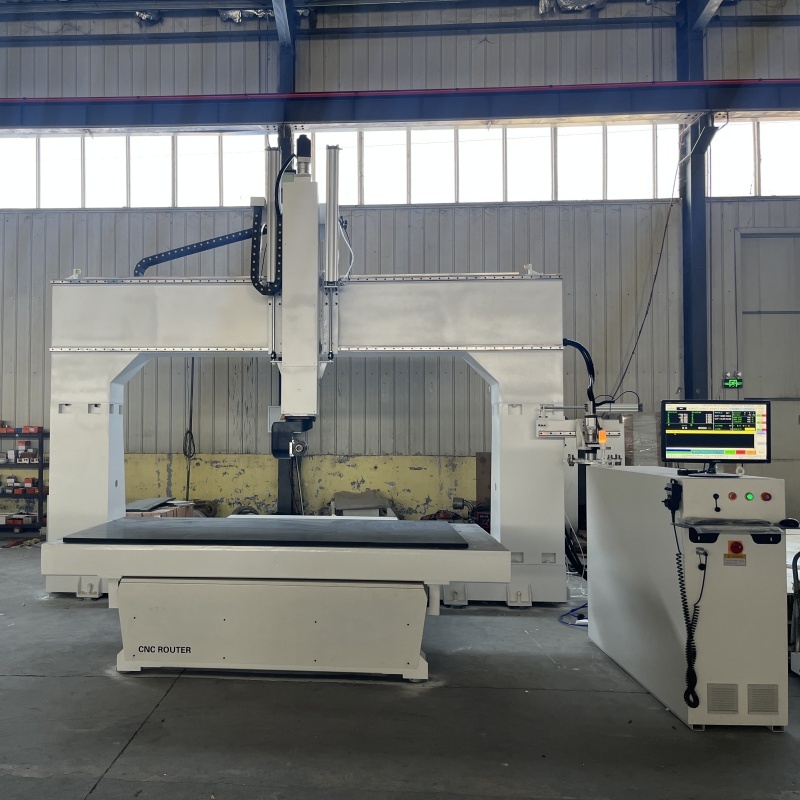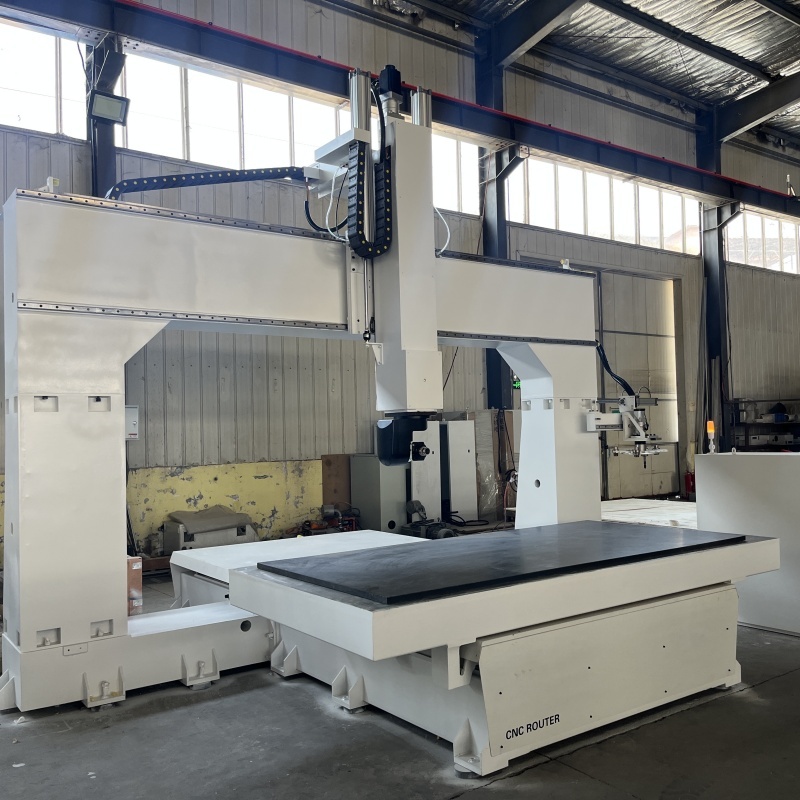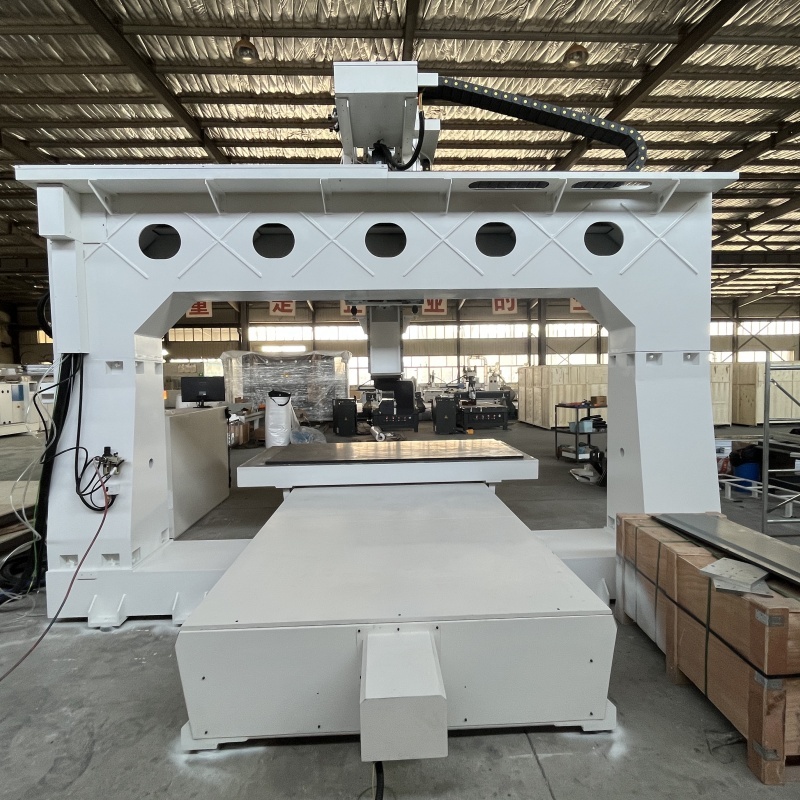As the woodworking industry rapidly develops, traditional processing equipment is increasingly unable to meet the demands of high-precision, complex production. Five-axis woodworking engraving machines, with their unique technological advantages, have become a key force driving industry change. They transcend the processing limitations of three-axis engraving machines. Through multi-axis collaborative operation, they offer comprehensive upgrades in efficiency, precision, and creativity for woodworking, making them the preferred choice for a growing number of woodworking companies and workshops.
The core advantage of five-axis woodworking engraving machines lies primarily in their enhanced processing efficiency and precision. Traditional three-axis engraving machines require frequent disassembly and re-clamping when processing irregularly shaped or multi-sided workpieces. This is not only time-consuming and labor-intensive, but can also lead to reduced precision due to positioning errors, often exceeding 0.1mm. The five-axis engraving machine, through the linkage between the spindle and the worktable, can complete multi-dimensional machining of workpieces, including front, side, bevel, and curved surfaces, in a single clamping. For example, when machining a wooden stair railing, it can complete curved cutting and surface carving simultaneously, with precision tolerances of 0.02-0.05mm, while reducing processing time by over 40%. Furthermore, its ability to process complex shapes far exceeds that of traditional equipment. Whether it’s the three-dimensional reliefs and openwork patterns on classical furniture or the uniquely shaped cabinets and curved door panels of modern homes, a five-axis engraving machine can accurately reproduce the design drawings through its CNC system. For example, in the case of rosewood furniture, a complex bed railing previously took 3-5 days to carve by hand, but a five-axis machine only takes 4-6 hours. The machine also ensures exacting patterns and dimensions for every piece, eliminating the inherent consistency inherent in manual engraving. Furthermore, the five-axis engraving machine offers high material utilization. Its intelligent path planning system optimizes the cutting path based on the workpiece shape, reducing wood waste. For processing precious woods like red sandalwood and Hainan Huanghuali, this advantage can directly reduce material costs by 15%-20%, saving companies considerable expenses.

In terms of application scenarios, the five-axis woodworking engraving machine has been applied across multiple sub-sectors of woodworking. In the field of classical furniture manufacturing, it is a powerful tool for replicating traditional craftsmanship. Whether it is the mortise and tenon structure and cloud dragon relief carvings of Ming and Qing furniture, or the Roman columns and carved decorations of European furniture, five-axis equipment can accurately reproduce them, contributing to the preservation of traditional wood art culture and the scale-up of production. After a rosewood furniture company introduced a five-axis engraving machine, the production cycle of Ming and Qing style sofas was shortened from 20 days to 7 days, annual output increased by two times, and the qualified product rate increased from 85% to 99%. In the custom home furnishing industry, five-axis engraving machines perfectly meet the demand for “personalization.” Meeting consumer demands for custom-shaped ceilings, curved wardrobe doors, and customized wooden background walls, these machines can quickly adjust processing parameters, enabling “customer-specific design and production,” helping home furnishing companies stand out in the fiercely competitive market. In the arts and crafts and cultural and creative industries, five-axis engraving machines offer creators greater creative freedom. From fine-grained carving on small wooden tea sets and ornaments to three-dimensional shaping of large wooden sculptures, these machines accurately capture design concepts, promoting the development of high-quality and diverse cultural and creative products. Furthermore, in the architectural decoration field, five-axis engraving machines can produce wooden ceiling shapes, wall reliefs, and wooden screens, creating unique decorative effects for hotels, villas, and high-end commercial spaces, enhancing the overall quality of the interior.
When purchasing a five-axis woodworking engraving machine, consider your specific needs and avoid blindly following trends. First of all, we should pay attention to the core performance parameters of the equipment. The spindle speed directly affects the cutting efficiency and processing quality. It is recommended to choose according to the hardness of the wood being processed: for processing softwood (such as pine and fir), a spindle of 8000-12000r/min can be selected, and for processing hardwood (such as mahogany and walnut), a high-speed spindle of 15000-18000r/min is required; the guide rail is the “skeleton” of the equipment operation. The accuracy and wear resistance of the linear guide rail are better than those of the ball guide rail, which is suitable for processing scenarios with high precision requirements; the CNC system is the “brain” of the equipment. Well-known brands such as Siemens and FANUC have stronger system stability and a more user-friendly interface, which can reduce the probability of failure during the processing process. Secondly, it is necessary to match the scale of production with the processing needs. If small and medium-sized workshops mainly process small handicrafts and customized home accessories, they can choose equipment with a work surface of 1300×2500mm and a spindle power of less than 5.5kW, which is more cost-effective. Large furniture companies or manufacturers that process large components need to choose models with a work surface of 2000×3000mm or more and a spindle power of more than 11kW to meet the needs of mass production and large-size workpiece processing. Finally, after-sales service is a key factor that cannot be ignored. The structure of a five-axis woodworking engraving machine is complex, and subsequent maintenance and repair are relatively difficult. When purchasing, it is necessary to confirm whether the manufacturer provides on-site installation and commissioning, regular maintenance and servicing services, and whether there is a professional technical team to provide rapid fault response (the recommended response time is no more than 24 hours). At the same time, pay attention to whether the manufacturer provides operation training to ensure that employees can quickly master the equipment operation skills to avoid equipment damage or processing errors due to improper operation. As the woodworking industry shifts toward intelligent and sophisticated processing, five-axis woodworking engraving machines are no longer exclusive to “high-end equipment” but are now essential tools for improving production efficiency, ensuring product quality, and expanding business scope. Whether you’re a classic furniture company committed to preserving traditional craftsmanship, a home furnishing manufacturer specializing in personalized customization, or a studio dedicated to developing cultural and creative products, choosing the right five-axis woodworking engraving machine can inject new momentum into your development and gain a competitive edge in the industry.




